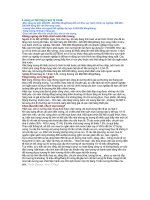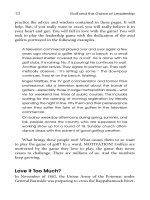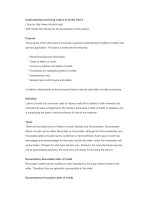Tài liệu Golf and the game of leadership 11 doc
Bạn đang xem bản rút gọn của tài liệu. Xem và tải ngay bản đầy đủ của tài liệu tại đây (218.55 KB, 10 trang )
90
Golf and the Game of Leadership
Still, no improvement. The complaints continued.
Management messages sent to the workers became more
strident. Workers needed to be motivated and inspired to
build a better vehicle. Posters were put up throughout the
plant. Suggestion plan awards were increased. More
meetings were held. The problems only got worse. Cus-
tomer complaints continued in greater numbers. Sales
began to waver. Repair costs escalated. Dealers were
really upset. More blame was directed at the workers. ‘‘If
only the line workers would pay more attention to what
they’re doing, we wouldn’t have these problems.’’ Meet-
ings were held with union leaders, who were told the work-
ers needed to do a better job and union leadership could
help make this happen.
Finally, top management at headquarters, frustrated with
the lack of success, took action. One of the firm’s most ex-
perienced manufacturing executives was dispatched to
spend a day in the assembly plant to see whether he could
determine what was going on. He talked with the workers.
He walked through every workstation, observed assembly,
and asked questions. He rode vehicles through the wind-
noise and water-leak tests. He questioned the line supervi-
sors, examined tools, studied the manufacturing process,
and read the quality statistics. Then, he once again ob-
served the way the assemblers did their work at each of
the line stations, and he talked more with them.
The following morning, at an informal breakfast meeting
with several other headquarters executives, he told of his
experiences at the plant. ‘‘Yesterday, I had the most inter-
esting experience I’ve had in my twenty-eight years with
the company. I can sum it up in two sentences: Our prob-
lem is not that the workers don’t know what they are doing.
As a matter of fact, they are the reason production is not
a lot worse than it is.’’ His listeners were astonished as he
10589$ $CH8 02-23-04 16:44:59 PS
91
Focus
continued to explain that it was only because of the skill,
dedication, and hard work of the assemblers that the vehi-
cles were as good as they were and that there weren’t
more problems. How could this be?
He continued his observations. ‘‘We’ve been building this
model for the past eight years and have considered phas-
ing it out and replacing it with a new model. But sales have
remained brisk. The customers have been very loyal. The
production costs have long since been amortized and so
our profit margins have been excellent. So, we’ve pre-
viously decided not to discontinue the model’s production
so long as there is a market of satisfied, loyal customers. As
this has been happening, the plant’s management, and
we here at headquarters, have turned our attention away
from this operation and not supported the production
processes.
‘‘We haven’t put a nickel in the operation for years. The
tooling is worn out. The machines are out of spec. The dies
won’t hold to specifications. Sheet metal won’t align prop-
erly. Doors won’t fit. Moldings won’t align. The inspection
processes have lapsed. Machine maintenance has been
reduced and new tools have not been provided. The list is
endless. In short, the system that we as management have
in place in the operation is incapable of producing the
level of quality we want and need. And, it is only the supe-
rior effort and skill of the assemblers that is overcoming that
lack of capability and making it work at all!’’
Leadership Lessons
So, what are the leadership lessons in the foregoing example?
1. Whenever you think a process is working just right, as a
leader you need to avoid the temptation to focus all your attention
on other issues. Don’t take your eye off the ball.
10589$ $CH8 02-23-04 16:44:59 PS
92
Golf and the Game of Leadership
2. Sometimes, even when you think a process is not broke,
you should break it. Tiger Woods won the 1997 Masters Champi-
onship by 12 strokes with a record score of 270. It is well known
that after celebrating his win for a week or so, he looked at videos
of his play and determined he had numerous flaws in his swing,
particularly in his iron play. He took the next year to overhaul his
swing and in another two years, in 2000, played what he calls the
‘‘best golf of my life.’’ In his book, How I Play Golf, Tiger com-
ments, ‘‘I don’t know if anyone will ever achieve a state of perfec-
tion [with the golf swing], I know I haven’t. But you can bet I’ll
keep trying.’’
1
Just as the golf swing is always a work in progress,
so too the leader should view leadership practices in place as al-
ways needing to be in focus. And that is regardless of how good a
leader you are, or think you are.
3. Don’t waste time blaming the workers or staff when things
go wrong. Remember that on hole ࠻6 you were asked to review
the first basic principle, which is to ‘‘always focus on the situation,
issue, problem, decision, or behavior, and not on the person.’’
Spend your time examining the system. Don’t ask, ‘‘Why can’t
my people build a good product?’’ Ask, ‘‘What is it about the
system that produces defective products?’’ School critics are fond
of asking, ‘‘Why can’t Johnny read?’’ when they should be asking,
‘‘What is it about our program to teach reading that produces
students who can’t read?’’ Remember, managers work IN the sys-
tem, leaders work ON the system.
4. Who has the greatest effect on the performance of a ship
at sea? The captain? The navigator? The chief engineer? Well, it’s
none of the above. It is the ship’s designer who affects the ship’s
performance more than anyone else. Leaders are designers. Think
of them as golf club designers. They need to concentrate on pro-
viding the best tools, systems, and processes for achieving objec-
tives, whether on the golf course or in the organizational
environment. Their focus should be on continuing success and
making change before change is made necessary by someone who
has had their eye on the future
10589$ $CH8 02-23-04 16:45:00 PS
93
Focus
Just the Facts
Leaders and golfers need to be able to focus their attention on the
situation or issue confronting them. In addition, leaders need to
focus on behavior and not on the person(s). Leaders must deal
with the facts and not with their feelings. They should know the
feelings of others, for these are facts, but must set aside their own
feelings as not being factual but subjective data. So, simply stated,
it is a fundamental principle that leaders focus on the situation,
issue, or behavior and not on the person. As Sergeant Joe Friday
of Dragnet fame would say, ‘‘Just give me the facts, ma’am, just
the facts.’’
In life, we as individuals are quite limited in what we are able
to personally control. If we are strict about the definition of con-
trol, we find the only thing we can really control is our own be-
havior. The golfer in playing a round of golf is affected by a variety
of elements over which he or she has no control. This can be
frustrating.
Albert
I was introduced to Albert, an inveterate golfer, about fifteen years
ago. The introduction occurred one morning as we were about to
begin a leadership session. One of the participants, recently re-
turned from an overseas assignment in England, handed me an
advertisement he had torn out of a magazine. It was a full page ad
for ‘‘Glenmuir Sportswear of Lanark, Scotland, Telephone 0555
2241.’’ Readers were asked to ‘‘Visit your local pro shop and ask
for Glenmuir golfwear. Our high quality pullovers, intarsias, and
cardigans are made from 100 percent pure double lambswool.
Pullovers, shirts, and jackets are available in a wide range of fash-
ionable colours.’’ This was the only reference to Glenmuir on the
page. The rest of the page was devoted to the tale of ‘‘Albert’s
Ashes.’’
Albert was ninety-five years old and had played golf for eighty
years. He loved his golf, and he never played without his Glen-
10589$ $CH8 02-23-04 16:45:00 PS
94
Golf and the Game of Leadership
muir cashmere pullover. [Oops—forgot this crass commercial
reference.] Albert’s only regret during his long playing career
was that he had never holed out on the 18th green.
He would play his drive into the river that crossed the
fairway, or lose his ball in the severe rough on the left. Some-
times, already beaten, he would pick up before his final putt.
The opening day of the season arrived and Albert was
playing inspired golf. He had played 17 holes in par and had
now put his second shot on the 18th within six inches of the
pin.
Albert withdrew his putter, lined it up, took his stance,
and died of a heart attack. After the cremation, his widow
explained to the vicar that she would like Albert’s ashes to be
placed in the hole on the 18th green.
At last Albert’s time had come. Every member turned out
to see his widow perform the ceremony. She knelt down by
the hole, closed her eyes, tipped the urn . . . and the wind blew
Albert out of bounds.
As Albert knew from his life and death experiences on his
club’s 18th hole, there was much that was outside his own sphere
of control (see Figure 8-1). In fact, in the strict sense of control,
Albert, like the rest of us, controlled only his own behavior. And
sometimes we are better at doing it than at other times. Witness
the behavior of golfers such as ‘‘Terrible Tommy’’ Bolt, John
Daly’s past behavior on not-so-good holes or days, or Kevin
Costner’s character in the movie Tin Cup. The golfer pays a price
when he or she loses control, so does the leader. And they have
only themselves to blame.
The Spheres of Influence
Outside the sphere of control, as shown in Figure 8-1, is the
sphere of influence. The golfer attempts to exercise influence over
the environment by taking into account such things as the lie of
the ball, distance to the hole, wind, natural impediments, the cad-
dy’s advice, and so on. The leader influences outcomes through
10589$ $CH8 02-23-04 16:45:01 PS
95
Focus
FIGURE 8-1.
Spheres of influence.
I
c
a
n
n
o
t
c
o
n
t
r
o
l
.
.
.
o
r
i
n
f
l
u
e
n
c
e
I
c
a
n
i
n
f
l
u
e
n
c
e
I can
control
W
hat can you control?
W
hat can you influence?
W
hat can’t you control or influence?
associates, peers, the boss, spouse, clients, or groups. The size of
this sphere is dependent on a person’s skills as leader and commu-
nicator and it can expand in proportion to how well these skills
are exercised. This is the portion of the sphere of influence that
offers the greatest opportunity for leadership growth.
Influence is exercised by asking questions: ‘‘What are you
going to do?’’ ‘‘What can I do to help?’’ ‘‘How should we pro-
ceed?’’ No matter how these questions are answered they will help
to focus on the situation, issue, or behavior that is being acted
upon. They will flush out whether in fact there is opportunity to
exercise some influence.
It is critical to a golfer’s success to maintain focus on those
10589$ $CH8 02-23-04 16:45:02 PS
96
Golf and the Game of Leadership
elements of the game that their behavior can control or influence.
The same applies to the leader playing the leadership game. One
of the major causes of stress for leaders is not focusing their ac-
tions appropriately because they fail to recognize what they need
to control and what they can only influence.
I entered the Navy as an ensign commissioned through the
NROTC program at Marquette University. As a midshipman, I
received some training and indoctrination, but simply stated, I
was the stereotypical ‘‘bull ensign’’ reporting to active duty. How-
ever, I had a coach, my older brother, Ray, who had survived the
European Theatre in World War II. He advised me to seek the
help of the leading enlisted person assigned to the shipboard divi-
sion for which I was given responsibility. Thanks Coach Ray!
I reported aboard the USS Lincoln County (LST 898) on an
August evening in Yokosuka, Japan. The next morning I went to
Chief’s quarters and introduced myself to Chief Quartermaster
Dominic Bruni. Notice, I did not ask the Chief to come to Offi-
cer’s Country, but rather went to his home turf. During our con-
versation, I explained to the Chief that I really didn’t know much
about electronics or many of the other aspects of our divisional
(operations) responsibilities. This was, of course, no surprise to
the Chief! We wound up our conversation with my request for
the Chief’s ‘‘help’’ in learning my job responsibilities and in being
able to lead the division so that we could perform as effectively as
possible. His response was a sincere, ‘‘Yes, sir,’’ and Chief Bruni
lived up to that commitment. He was my first caddie and at the
time I’d yet to play my first round of golf. Never forget Chief Bruni!
I had another lifelong learning experience about eighteen
months later. I was still serving aboard the USS Lincoln County
in the not-so-glamorous ‘‘Gator Navy,’’ which was the amphibi-
ous ships and equipment dedicated to supporting troop move-
ments and amphibious landings. I was within six months of
release from active duty or transfer to another command. Our
new commanding officer thought it would be a good idea to move
his officers around and have them gain experience in other assign-
ments. This is an excellent concept, as I have learned over the
10589$ $CH8 02-23-04 16:45:02 PS
97
Focus
years, but at the time I didn’t think so. After all, I was comfortable
in my billet. Control and influence were in good balance.
Well, my new assignment was to be the First Lieutenant. The
responsibilities included all the above-deck evolutions of the ship,
such as anchoring, mooring, loading and off-loading materials
and equipment, servicing and manning our two anti-aircraft bat-
teries, maintenance and painting, and so on. None of this fell
within either my skill or interest level. Consequently, though the
Captain said ‘‘here’s what you’re going to do’’ and I said ‘‘aye,
aye, sir,’’ my mind was saying ‘‘I really don’t want to do this!’’ I
know many of you have had this kind of experience.
The fight was on between what I physically had to do and
what I mentally didn’t want to do. I wanted to control the situa-
tion and not do what I’d been assigned to do. This I call self-
inflicted stress, and it causes both mental and physical distress. I
began to experience both. As I struggled, I was helped by my wife
Ann, who had her own hands full with a baby, Mark, and who
was pregnant with Tim. She didn’t need another ‘‘baby’’ on her
hands!
Fortunately, we remembered the lesson learned eighteen
months before, which I’d forgotten at the time but have remem-
bered ever since. It was my brother’s advice. Acknowledge what
you know and, more importantly, what you don’t know, and get
the help needed. So, once again I made a special trip to Chief’s
quarters. This time it was to see Chief Gunner’s Mate Warren
Brickey, who was the leading petty officer for my newly assigned
Deck Division. We struck the same deal that Chief Bruni and I
had agreed upon eighteen months before. Once again reality was
recognized. Control and influence were properly assigned, and life
was great. Never forget Chief Brickey!
I feel very fortunate to have learned at an early adult age the
following lesson, which I’ve tried to practice. Those who know me
best have heard me offer it to them, probably too many times. But
it is so valuable. ‘‘Remember, control yourself the best you can,
try to exert as much influence as possible to make the right things
happen, and don’t spend your time thinking and worrying about
10589$ $CH8 02-23-04 16:45:03 PS
98
Golf and the Game of Leadership
that which you cannot control and/or influence.’’ You’ll be more
productive and as a bonus you will sleep better each night!
The golfer knows that once the club has been swung, the con-
tact with, flight, bounce, and roll of the ball is out of his or her
control and influence. The effective leader knows that you can
lead by example. You can influence others by communicating
your expectations. You can work to establish a motivational envi-
ronment. However, only they can control their behavior. The be-
lief that you can control the behavior of others, including those
you lead, brings stress and self-doubt when you fail to do so.
It is possible to become so focused on all the things you can-
not control and/or influence that you lose sight of what you are
in fact capable of doing. When that happens you can create a lot
of unhealthy anxiety and frustration for yourself. For golfers, their
scores go up and their ability to compete at an acceptable level is
threatened. For leaders, it blurs the realistic sphere of control and
influence and will probably result in a drop in performance.
Tiger Woods may be a brilliant performer on the golf course,
yet Tiger is also human. The game is golf. You, the leader, are
human. The game is leadership. On the golf course and in leader-
ship, perfection is a myth. You can make a positive difference,
however, and you can approach excellence if you maintain a focus
on what you can realistically accomplish and conscientiously and
courageously pursue that focus. The golfer decides which club can
best control the shot required, selects the club that can best influ-
ence the desired result, focuses, and executes the shot. The leader’s
execution needs to be no less focused.
Here are a few suggestions to help you focus:
■
Control your time.
■
Avoid distractions that take you away from your priorities.
■
Control your emotions.
■
Question every meeting invitation.
■
Don’t over-react when things go badly.
■
Maintain your self-confidence.
10589$ $CH8 02-23-04 16:45:03 PS
99
Focus
■
Give yourself time to think.
■
‘‘Close the door.’’
■
Buy another wastebasket!
I’m playing great, for me, and then I just lose my focus.
Ken Smith, fellow duffer
Quick Tips for Improving Your Leadership
Game
Real leaders typically understand and model the following in their
day-to-day actions:
■
Life will be much simpler and far less stressful if you focus
on and work within your ‘‘sphere of influence.’’
■
Direct your energies to achieving short-term goals and ob-
jectives but never lose sight of the ultimate purpose (vision)
you are pursuing.
■
Maintain a constancy of purpose. Avoid the ‘‘program of
the day’’ syndrome.
■
Help others succeed.
10589$ $CH8 02-23-04 16:45:04 PS









